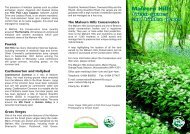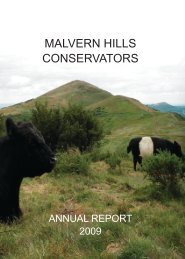Footpath degradation of the Malvern Hills - Malvern Hills Conservators
Footpath degradation of the Malvern Hills - Malvern Hills Conservators
Footpath degradation of the Malvern Hills - Malvern Hills Conservators
You also want an ePaper? Increase the reach of your titles
YUMPU automatically turns print PDFs into web optimized ePapers that Google loves.
Stephen Britnell<br />
<strong>Footpath</strong> <strong>degradation</strong> <strong>of</strong> <strong>the</strong> <strong>Malvern</strong> <strong>Hills</strong><br />
This equation has restrictions as it simplifies <strong>the</strong> problem <strong>of</strong> erosion by only taking<br />
into account run<strong>of</strong>f, also that <strong>the</strong> plot <strong>of</strong> land affected is <strong>of</strong> constant width, slope, material and<br />
land cover. However, it is a useful tool in quantifying soil loss, even if <strong>the</strong> results may give an<br />
under estimation.<br />
Deluca et al. (1998) looks at <strong>the</strong> influence <strong>of</strong> llamas, horses and hikers on soil erosion<br />
from established recreation trails in western Montana, USA. The primary objective <strong>of</strong> this<br />
research was to assess <strong>the</strong> relative impact <strong>of</strong> horses, llamas and hikers on paths. A<br />
secondary objective was to better understand how recreational pressure leads to path<br />
erosion. Erosion potential was expected to increase with a rise in traffic. Deluca et al. (1998)<br />
found this to be true, as traffic rose, so too did <strong>the</strong> detachment and compaction <strong>of</strong> soil<br />
particles, and <strong>the</strong> concentration <strong>of</strong> flow into channels.<br />
The recreational paths used were two 300m segments <strong>of</strong> parallel paths that were<br />
closed to <strong>the</strong> public after <strong>the</strong> 1995 snow melt. The paths were <strong>the</strong>n subject to intensities <strong>of</strong><br />
250 and 1000 passes, along with no traffic for control. This was assessed by sediment yield<br />
and run<strong>of</strong>f. Deluca et al. (1998) recorded soil moisture, slope and rainfall intensity as<br />
independent variables to keep <strong>the</strong> experiment as constant as possible.<br />
The main finding <strong>of</strong> this paper is that horse traffic consistently made more sediment<br />
available for erosion from paths than llamas and hikers, when analysed across wet and dry<br />
plots with high and low intensities <strong>of</strong> traffic (Deluca et al. 1998). When trail traffic was<br />
increased by a factor <strong>of</strong> 4, from 250 passes to 1000 passes, sediment yield rose by only a<br />
factor <strong>of</strong> 1.4 (Deluca et al 1998). This suggests that initial trail traffic is much more damaging<br />
than subsequent traffic.<br />
The study by Deluca et al. (1998) is useful in grading <strong>the</strong> erosive power <strong>of</strong><br />
recreational traffic on footpaths, and is useful information when considering this in my own<br />
study, although llamas are not commonly found on <strong>the</strong> <strong>Malvern</strong> <strong>Hills</strong>. However mountain bikes<br />
produce similar rates <strong>of</strong> erosion to that <strong>of</strong> llamas, and so may be used instead.<br />
3





